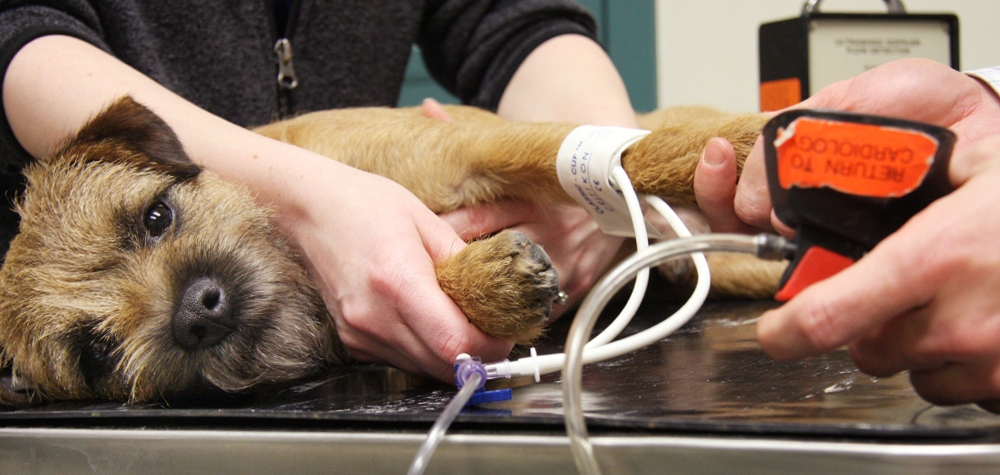Things to Know Before Visiting a Board Certified Veterinary Cardiologist}
Wiki Article
What You Need to Learn About Veterinary Services: An Overview of Diagnostic Tools and Procedures
Veterinary services play a crucial role in keeping the health and wellness of animals. Normal examinations can disclose surprise health worries beforehand. Various diagnostic tools and treatments, such as blood examinations and imaging strategies, offer vital understandings right into an animal's wellness. Understanding these methods is crucial for family pet owners. What certain analysis procedures are most commonly made use of, and exactly how can they influence an animal's treatment plan?Importance of Routine Vet Check-Ups
While many family pet proprietors may undervalue the significance of normal veterinary exams, these visits are crucial for maintaining a pet's total health and wellness. Regular check outs to the vet enable very early detection of prospective health problems prior to they escalate into major troubles. Routine examinations usually consist of inoculations, which are very important for avoiding infectious diseases that might seriously impact an animal's wellness. In addition, these appointments offer a possibility for veterinarians to assess the pet's weight, dental health, and general condition, ensuring that the family pet is thriving. Throughout these gos to, pet dog proprietors can additionally receive beneficial recommendations on diet plan, exercise, and precautionary care customized to their particular animal's demands.Typical Diagnostic Treatments in Vet Medication
In veterinary medicine, exact medical diagnosis is vital for reliable therapy. Typical diagnostic treatments include blood testing techniques, progressed imaging technologies, and urinalysis, each playing a significant function in recognizing wellness concerns. Understanding these techniques boosts the capacity to give proper look after pet patients.Blood Checking Techniques
Blood screening methods work as necessary analysis devices in veterinary medication, enabling veterinarians to evaluate the health and wellness of pets precisely. These strategies entail accumulating blood examples to assess different components, such as white and red blood cells, platelets, and biochemical markers. Typical examinations consist of complete blood matters (CBC), which assess overall health and wellness and identify infections, and biochemical panels, which examine body organ feature and metabolic standing. Furthermore, serological tests can recognize specific illness via antibody detection. Blood screening is minimally intrusive and provides vital information that assists in detecting conditions, monitoring health and wellness standing, and examining responses to therapies. On the whole, these techniques play a crucial role in making certain perfect look after pet dogs and animals alike.Imaging Technologies Made Use Of
Diagnostic imaging technologies are vital devices in vet medicine, complementing blood testing techniques by giving aesthetic insights into an animal's interior frameworks. Typical imaging methods consist of X-rays, which work for reviewing bone cracks and detecting foreign objects, and ultrasound, which enables real-time visualization of soft tissues and organs. Magnetic resonance imaging (MRI) provides thorough photos of intricate physiological locations, specifically in neurological assessments. Calculated tomography (CT) gives cross-sectional photos, boosting analysis precision for different conditions. Each of these innovations aids veterinarians in diagnosing diseases, planning treatments, and keeping an eye on healing. By integrating imaging innovations, veterinary specialists can much better examine a pet's health and wellness and make informed decisions regarding their treatment.
Urinalysis and Diagnostics
Urinalysis offers as an essential analysis device in veterinary medicine, giving beneficial understandings right into an animal's overall wellness and assisting in the discovery of different conditions. This non-invasive treatment examines pee samples to assess kidney feature, hydration condition, and metabolic disorders. Common parts checked out include particular gravity, pH levels, sugar, proteins, and the visibility of blood or microorganisms. Uncommon findings can show problems such as urinary system system infections, diabetes mellitus, or kidney condition. To improve analysis precision, urinalysis is usually done combined with various other tests, such as blood job and imaging studies. Early discovery through urinalysis can cause prompt interventions, enhancing the prognosis for lots of veterinary individuals. It is an essential element of detailed veterinary treatment.Understanding Blood Tests and Research Laboratory Analysis
Understanding blood tests and lab evaluation is crucial in vet medicine as it helps in diagnosing numerous health problems in pets. Different sorts of blood examinations offer vital details concerning an animal's internal state, while analyzing laboratory results calls for careful factor to consider of numerous elements. This section will explore the sorts of blood examinations available and the importance of their results.Kinds Of Blood Tests
Blood tests play a vital duty in veterinary medicine, providing vital understandings right into a pet's wellness standing. Numerous sorts of blood examinations are made use of, each offering various objectives. Total blood matters (CBC) examine general health and wellness and spot problems such as anemia or infection. Biochemical accounts examine organ function by gauging enzymes and electrolytes, providing insights right into metabolic health and wellness. Serological examinations recognize certain antibodies or microorganisms, helping in the medical diagnosis of infections or autoimmune conditions. Blood keying warranties secure transfusions, while coagulation examinations evaluate the blood's ability to embolisms, crucial for surgeries. These tests jointly improve diagnosis, treatment planning, and monitoring of a pet's wellness, showing the significance of thorough research laboratory evaluation in veterinary treatment.
Analyzing Lab Outcomes
A comprehensive analysis of lab outcomes is vital for exact diagnosis and treatment in veterinary medicine. Translating lab results needs an understanding of normal reference varieties and the relevance of inconsistencies. Blood tests can expose different wellness indications, such as body organ feature, electrolyte balance, and the visibility of infections. Veterinarians must think about the whole medical picture, consisting of the animal's history, physical exam searchings for, and any kind of symptoms offered. Variants in outcomes might emerge from factors such as age, type, and underlying wellness problems. Subsequently, laboratory outcomes must not be checked out in seclusion yet instead as component of a comprehensive analysis strategy. Accurate interpretation permits customized therapy plans and better outcomes for vet individuals.Imaging Techniques: X-rays, Ultrasounds, and Beyond
Imaging methods are necessary tools in veterinary medication, supplying crucial insights right into the wellness and wellness of pets. Among one of the most frequently utilized methods are Ultrasounds and x-rays. X-rays are vital for envisioning bone frameworks, helping veterinarians recognize fractures, tumors, or international objects. This approach is quick and non-invasive, making it perfect for immediate situations.Ultrasounds, on the other hand, make use of acoustic waves to create pictures of soft tissues and organs. This strategy is particularly beneficial for checking out the heart, abdomen, and reproductive body organs, allowing vets to assess conditions like liquid accumulation or organ abnormalities.Beyond X-rays and ultrasounds, progressed imaging techniques such as computed tomography (CT) and magnetic vibration imaging (MRI) are increasingly made use of in websites veterinary practice. These methods provide thorough cross-sectional photos, improving the precision of medical diagnoses and treatment strategies. Ultrasound For Dogs. Generally, imaging methods play a necessary role in making sure reliable vet treatmentThe Duty of Biopsies in Diagnosing Pet Dog Health And Wellness Issues
Accuracy in diagnosing health problems in pet dogs usually rests on the use of biopsies, which provide conclusive information regarding cells problems. A biopsy involves the removal of a little example of cells for exam under a microscopic lense, allowing veterinarians to determine different problems, consisting of infections, lumps, and inflammatory diseases. This diagnostic tool is vital for identifying in between deadly and benign growths, leading treatment decisions, and examining the extent of a condition.Biopsies can be executed making use of numerous strategies, such as needle desire, incisional biopsies, or excisional biopsies, depending on the area and type of tissue involved. The selection of approach might impact recuperation time and the quantity of tissue collected. Ultimately, the information gleaned from a biopsy can result in targeted therapies, boosting end results for pets encountering significant wellness difficulties. Veterinarians highlight the significance of this procedure in attaining precise diagnoses and effective treatment strategies.Advanced Diagnostic Equipment: Endoscopy and CT Scans

Advanced diagnostic devices, such as endoscopy and CT scans, play a vital role in contemporary veterinary medication, using non-invasive methods to picture internal structures and identify numerous conditions in pet dogs. Endoscopy entails using a flexible tube furnished with a camera, enabling vets to analyze the stomach tract and respiratory system straight. This technique can disclose abnormalities such as tumors, foreign bodies, or inflammation, allowing targeted therapy plans.CT scans, on the other hand, use innovative imaging technology to produce comprehensive cross-sectional photos of the body (CT Scans For Animals). This approach is especially beneficial for evaluating facility frameworks like the mind, back, and joints. By giving high-resolution photos, CT scans help vets in identifying concerns that might not appear with typical radiography. Together, these advanced tools enhance diagnostic precision, enhance treatment outcomes, and ultimately add to better total animal health management

Interpreting Examination Results: What Pet Dog Owners Ought To Know
Understanding examination results can be a tough task for pet proprietors, especially after innovative procedures like endoscopy and CT scans have actually been carried out. Analyzing these outcomes requires an understanding of medical terms and a clear understanding of what the searchings for suggest about the family pet's health. Vets usually supply descriptions, but the intricacy see this website of the outcomes can still lead to confusion.Pet owners need to proactively participate in conversations with their veterinarians, asking questions to make clear any unpredictabilities. It is important to recognize unusual versus regular results and the ramifications for the pet dog's treatment plan. Additionally, recognizing that some results might call for further screening or surveillance can help proprietors remain educated concerning their pet's health and wellness trip. Ultimately, a collaborative method in between family pet proprietors and vet professionals fosters much better health and wellness end results and boosts the total care experience for family pets.Frequently Asked Questions
How Do I Choose the Right Vet Center for My Family pet?
Picking the appropriate vet clinic entails researching local options, reviewing qualifications, visiting centers, and assessing team interactions (CT Scans For Animals). Focusing on suggestions from trusted sources can aid guarantee the most effective treatment and setting for a family pet's health and wellness requirementsWhat Should I Do if My Family Pet Refuses to Go to the Veterinarian?
When a family pet declines to visit the vet, it's advisable to remain calm, use deals with or playthings to lure them, and think about arranging a home go to if stress and anxiety lingers. Perseverance and positive reinforcement are vital.Exist Telehealth Options for Veterinary Solutions?
Telehealth options for veterinary solutions are increasingly available, allowing animal owners to consult with veterinarians remotely. These services enable discussions about health and wellness worries, recommendations on small conditions, and follow-ups without needing to go to a center.
Exactly how Typically Should My Animal Have Dental Check-Ups?
The frequency of oral exams for pet dogs normally depends upon their age and type. Normally, veterinarians recommend annual dental evaluations, although some pets might visit this page call for more frequent sees to keep optimal dental health.
What Are the Expenses Connected With Veterinary Diagnostics?
The expenses connected with veterinary diagnostics can differ widely, usually varying from basic tests like blood work to innovative imaging strategies. Factors influencing costs consist of the facility's area, equipment used, and certain examinations needed for each animal. Veterinary solutions play a vital duty in keeping the health of animals. While lots of family pet proprietors might undervalue the importance of regular veterinary check-ups, these consultations are essential for keeping a pet's overall health and wellness. Additionally, these appointments offer a chance for veterinarians to evaluate the animal's weight, dental health and wellness, and general condition, guaranteeing that the pet dog is prospering. Precision in detecting wellness concerns in pet dogs commonly pivots on the use of biopsies, which offer definitive details concerning cells problems. Furthermore, acknowledging that some results may need additional screening or surveillance can aid proprietors remain notified about their pet's wellness trip.Report this wiki page